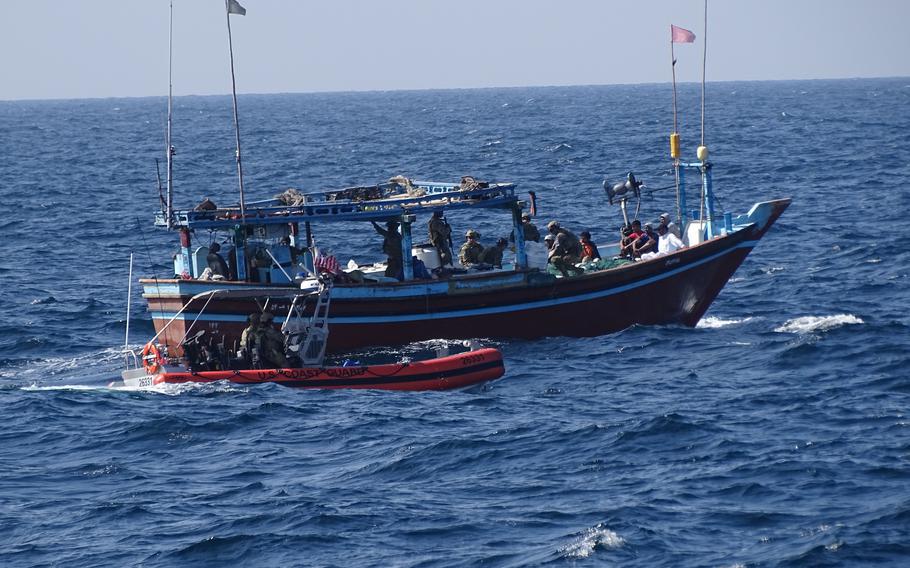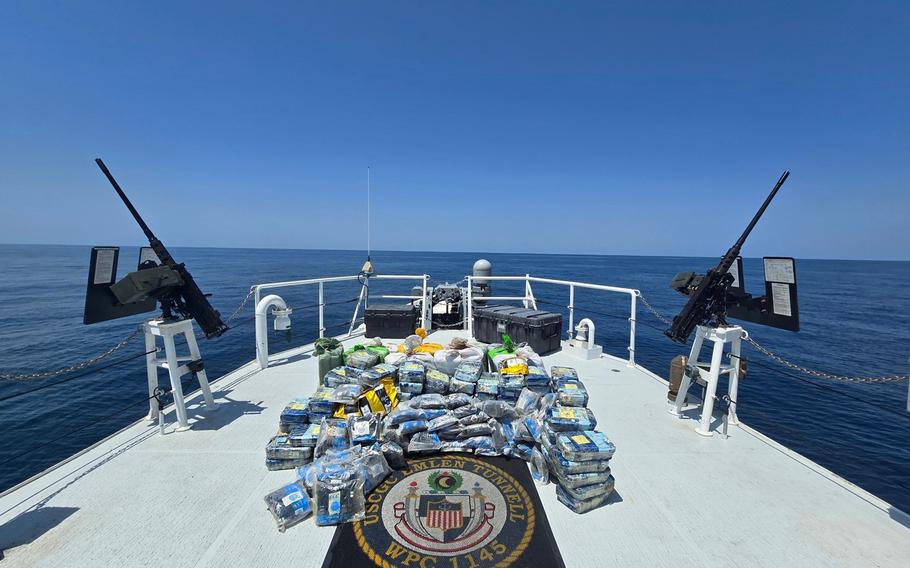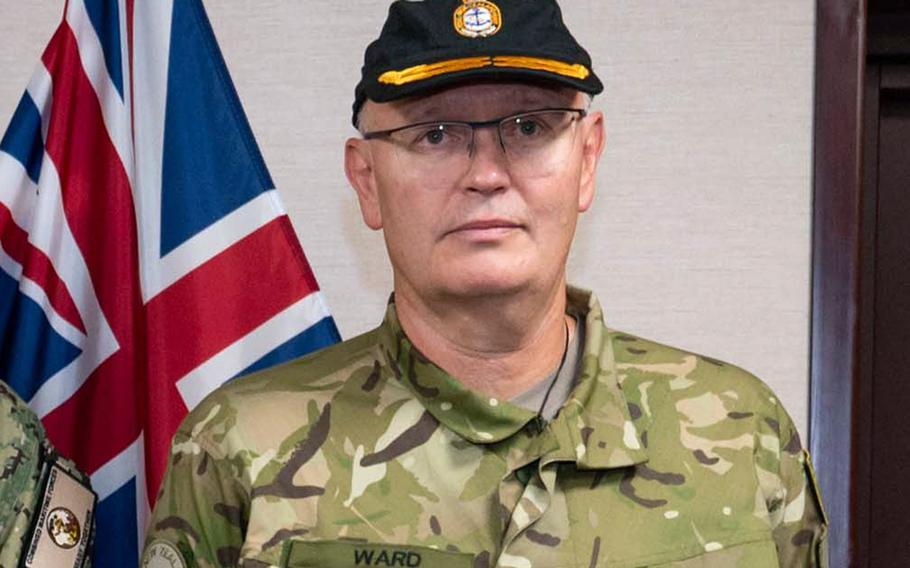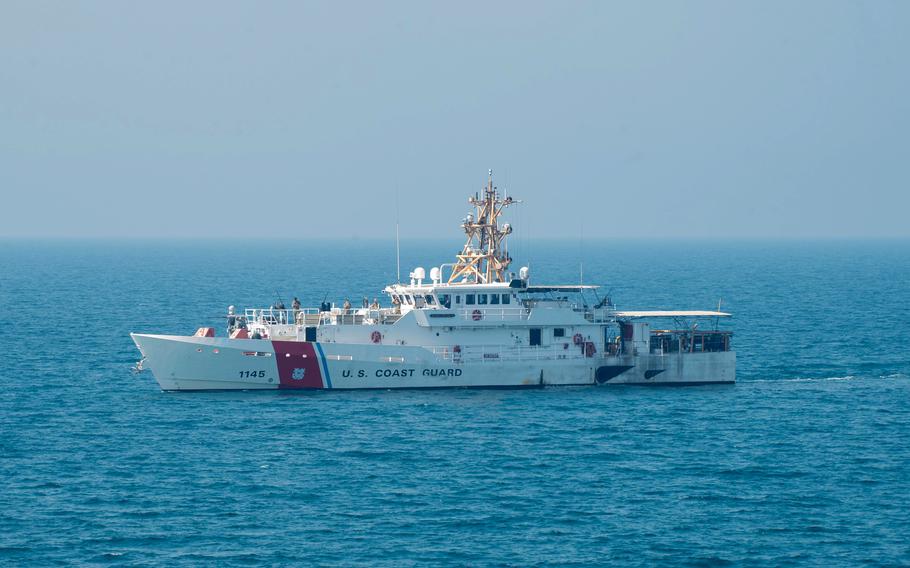
Coast Guardsmen from the USCGC Emlen Tunnell seize illegal narcotics from a stateless vessel in the Arabian Sea on Feb. 7, 2025. The interdiction was the first drug seizure since New Zealand assumed command of Combined Task Force 150 on Jan. 15. (U.S. Coast Guard)
MANAMA, Bahrain — Drug busts by a multinational Middle East task force responsible for maritime security have slowed in recent years, according to the current commander of the Bahrain-based coalition, which works closely with the U.S. Coast Guard.
New Zealand navy Commodore Rodger Ward, who has led Combined Task Force 150 since mid-January, recently noted the drop-off and said it may signal a shift in how terrorist organizations are moving illicit material in the region.
“When we look back at the stats, we have boarded more and seized less, comparatively speaking, over the last few years,” Ward said in an interview earlier this month.
In 2024, the task force conducted 55 boardings and made 17 seizures, a hit rate of about 30%, according to data from the Regional Narcotics Interagency Fusion Cell, which assists Combined Maritime Forces and U.S. Naval Forces Central Command in tracking illegal drug trading. That’s down from 2022, when it conducted 33 boardings and made 32 seizures.

Illegal narcotics seized from a stateless vessel are stacked on the deck of the USCGC Emlen Tunnell in the Arabian Sea on March 23, 2025. (U.S. Coast Guard)
The downward trend in interdictions has continued into 2025, Ward said. Since he assumed command, the task force has boarded 26 ships but made only six busts, he added.
Task Force 150 is one of five used by Combined Maritime Forces to patrol waterways in the Middle East. Large-scale drug busts and interdictions of weapons shipments have made up a significant part of the task force’s missions.
Coast Guard vessels operating from Bahrain share in the work of Combined Maritime Forces, a 46-country grouping under the command of the top U.S. naval officer in the region.
Terrorists such as the Taliban and the Iran-backed Houthis in Yemen rely on the smuggling channels to finance their activities. But Ward’s observation raises the prospect that the groups are shifting gears in an effort to evade confiscation.
Officials with the Combined Maritime Forces and at least one expert suspect the change may be due to supply limitations, deterrence methods and changes in vessels.

New Zealand navy Commodore Rodger Ward, commander of Combined Task Force 150. Ward said the task force has seen a drop-off in the number of drug seizures at sea in recent years. (U.S. Navy)
The decline in interdictions by CTF 150 likely means smuggling channels are growing more sophisticated rather than slowing down, said one seasoned Yemen researcher who studies such operations.
The expert, who was granted anonymity due to the sensitive nature of their research, said there has likely been an upscaling from small and medium-sized operations to a larger, more professional form of smuggling.
Rather than small, stateless dhows, container ships that disguise the illicit cargo as legal goods are seemingly the preferred option now, the researcher said.
Under the Law of the Sea, U.S. forces working with CTF 150 may board only small stateless vessels. Goods smuggled in large container ships can be made to look as if they’re coming from a legitimate country, making them harder for maritime security forces to monitor.
“It’s a much safer method of getting your goods to market, so to speak,” the researcher said.
Experts and former defense officials have said cutting off revenue streams and other resources will be key to defeating the Houthis if the U.S. wants to avoid the need for a ground incursion.

The U.S. Coast Guard fast response cutter USCGC Emlen Tunnell sails in the U.S. Central Command area of responsibility in November 2024. (Christ-Claude Mowandza-Ndinga/U.S. Army)
The frequent boarding and threat of interdiction, along with the presence of warships sent to the Middle East to battle the Houthis, could be playing a role in the slowdown, Ward said.
But it could also be that smugglers are using faster boats, drones or new coastal routes to move their stashes. He also noted that the global supply of heroin and opium has plummeted since the Taliban leaders of Afghanistan banned the cultivation of poppy and other narcotics in 2022.
“There’s a whole change of things that we still haven’t really figured out yet,” Ward said.
Smuggling networks have come under renewed scrutiny amid the U.S. airstrike campaign against the Houthis. The U.S. has issued multiple rounds of sanctions aimed at Iran’s illicit petroleum and crude oil sales, which help fund proxy groups like the Houthis.
Drug trafficking has been on the rise in Yemen, according to a recent report by a U.N. expert panel. The report, published in October 2024, pointed to a seizure of drugs from a sugar container at a port on the Gulf of Aden.
Ward said the Interagency Fusion Cell estimates that it captures about 7% of what’s being smuggled in its area of operation. He said he’d like to see more Persian Gulf nations address the problems that are coming to their ports and shores.
“I think what CMF is trying to do is get the regional partners to own the problems so it’s not just the big navies,” he said. “CMF’s goal is to get as many players as possible to actually contribute ... and solve this problem.”